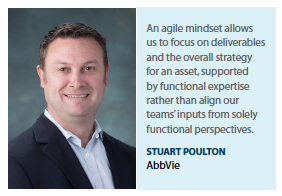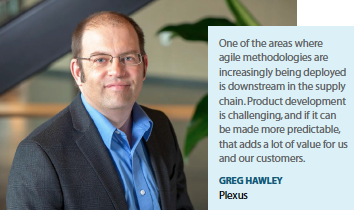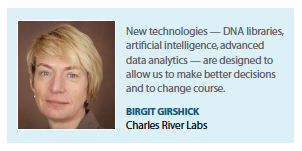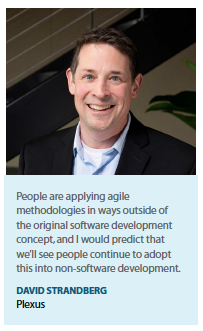A project management philosophy popular among technology companies has learnings for pharma R&D.
Agile project management, first introduced in 2001, started out as a method used in software development that challenged the traditional, linear development  model. The same benefits realized by the software industry, experts say, can be realized in pharmaceutical R&D. Agile takes a more iterative development approach with small parts of projects being built and tested simultaneously.
model. The same benefits realized by the software industry, experts say, can be realized in pharmaceutical R&D. Agile takes a more iterative development approach with small parts of projects being built and tested simultaneously.
McKinsey researchers define agile as the ability to quickly reconfigure strategy, structure, processes, people, and technology toward value-creating and value-protecting opportunities. For pharmaceutical R&D, this means faster reallocation of resources and enhanced engagement, which ultimately translates into dramatically reduced time to market.
Industry leaders stress being agile is different from previous efforts to bring efficiency to R&D. While fail fast and efficiency are expectations, the agile philosophy means the use of methodologies and processes, tools, platforms, and techniques combined with behavioral changes to achieve outcomes.
Fail early and fail often is not what companies are trying to accomplish, stresses Greg Hawley, engineering project manager, Plexus. “When we set up development to be agile, it’s about taking a product that we expect to be successful, monitoring the progress and getting feedback from our customers rapidly."
Pharma industry experts say there are many ways this project management process can be applied to pharmaceutical R&D. The principles associated with agile — including frequent communications, flexibility, iterating faster, building learnings into a project, etc. — can apply to a clinical development plan.
There is a need for change in drug development processes. Increasing budgets,  longer development life cycles; the development of precision medicine, immunotherapies, and other scientific innovations; rapidly changing regulations and standards; and the demands of patients for new medicines are creating more pressure on the industry to move products through the pipeline faster and with increased cost-efficiency.
longer development life cycles; the development of precision medicine, immunotherapies, and other scientific innovations; rapidly changing regulations and standards; and the demands of patients for new medicines are creating more pressure on the industry to move products through the pipeline faster and with increased cost-efficiency.
Technology is also playing a key role in the agile transformation journey. The implementation of risk-based monitoring enabled by machine learning and predictive analytics, smart trials, and medication using platforms enabling real-time connection of patient, device, and data are all allowing for a different way to approach drug development.
“The changes in the landscape of drug development and the advent of new technologies are leading companies to revisit drug development in different ways and evaluate different milestones," says Birgit Girshick, corporate executive VP of discovery and safety assessment, Charles River Labs. “Re-evaluating the conventional way of drug development was necessitated by cost, by trial failure rates, and by the different modalities that are coming out."
The term agile is definitely in fashion, Ms. Girshick says, and at Charles River they use words like speed and flexibility and are examining how these concepts can be applied to drug development. “We look at multi-faceted approaches, and we’ve begun partnering with a number of companies that have novel ideas and technologies. We’re focused on making technology and science more agile. We’re also looking at how to make historical processes faster, take white space out of the process, and add value."
An agile R&D organization is one that enables faster decision making through the value chain, says Rosemary Hegde, head of life-sciences business process services,  UK &Europe, TCS. “By reaching outcomes faster through an iterative approach the faster the expected outcomes can be achieved," she says. “An emphasis on smaller outcomes is part of the agile philosophy."
UK &Europe, TCS. “By reaching outcomes faster through an iterative approach the faster the expected outcomes can be achieved," she says. “An emphasis on smaller outcomes is part of the agile philosophy."
She says an agile approach could be initiated in multiple stages of research and development, which would lead to either fail fast or progress a molecule further down the drug development chain. “For example, this could be achieved by using high performance computing and focused algorithms in computational chemistry," Ms. Hegde says. “New age platforms using quick comparisons with prevalent medicine and new drugs are another example."
No company has time or money to waste, says Jackie Kent, senior VP, head of product, Medidata. “Patients are waiting for medicines, and if we can’t improve functionality fast enough for sponsors to deliver new medicines we’re not serving our customers," she says. “We eliminate waste all the time by using an agile method that allows us to communicate frequently. It serves the changing needs of the industry better than anything else especially a traditional waterfall method."
Medidata has implemented an agile process for the development of new features for many of its technology products. “We can deliver new functionality in eight weeks not six months," Ms. Kent says. “It’s a much tighter ecosystem and it serves both partners and sponsors much better. It also lets them give us feedback that we can then employ and turn around new functionality quicker."
“Agile development processes focus on flexibility and shorter timelines that allow for interim project assessment; this allows for broad applicability and inventiveness outside of just software development projects," says David Strandberg, director of engineering solutions for healthcare and life sciences, Plexus.
He tells the story of several Plexus engineers who in their spare time started a business in the local community, and how they used agile methodologies to manage the construction process.
“People are using these methodologies in ways outside of the original software concept, and I would predict that we’ll see people continue to adopt this approach  into non-software development," Mr. Strandberg says. “Agile methodologies provide value incrementally for our customers and we are already seeing it being adaptable to widespread product development needs," he says.
into non-software development," Mr. Strandberg says. “Agile methodologies provide value incrementally for our customers and we are already seeing it being adaptable to widespread product development needs," he says.
“A key element of agile methodologies is quickly creating prototypes, which is an offering we provide our customers to enhance the agile development process, outside of traditional software development," Mr. Hawley says. “One of the areas where these methodologies are increasingly being deployed is downstream in the supply chain," he says. “Product development is challenging and if you can make that more predictable, that adds a lot of value for us and our customers."
Agile Strategies for R&D
The pharmaceutical industry is still coming to understand how agile can be used in areas beyond software development.
Such agility can help a pharma company to transform its business models to achieve greater patient-centricity and personalized healthcare, more efficient drug development cycles, and improve real-time feedback.
In an agile R&D organization, the teams are lean and nonhierarchical, with shared goals and accountability for the specific outcomes, Ms. Hegde says. “This necessitates each team member to have a greater breadth of understanding of different roles with cross-functional skill development while holding deeper knowledge in the specialty that one is an expert in," she says. “The role of leadership is more focused toward enabling these teams to perform effectively."
Ms. Girshick says previous efforts at efficiency may have only looked to cut a year  or so from drug development. “The agile approach adds smart decision-making," she says. “New technologies — DNA libraries, artificial intelligence, or advanced data analytics — are designed to allow us to make better decisions and change course."
or so from drug development. “The agile approach adds smart decision-making," she says. “New technologies — DNA libraries, artificial intelligence, or advanced data analytics — are designed to allow us to make better decisions and change course."
Greg van Wyk, M.D., CEO of Noxopharm, agrees saying agile is about flexibility. "It’s about the ability to pick new skills up quickly and to move from one direction to another quickly," he says.
Noxopharm is a clinical-stage company developing an enhancer of radiotherapy across a range of cancers. While the company hasn’t implemented agile project management in a formal way, Dr. van Wyk stresses Noxopharm is an agile organization.
“We’re small and our different project teams move quite quickly from one initiative to another," he says. “We have a core group of people who have line of sight on most of the projects that we’re running and that enables us to employ the information and lessons that we have in one area very quickly into another."
Adaptive trials are another example of an agile approach, says Barinder Marhok, associate VP and head R&D center of excellence, life sciences, Cognizant. “The ability to change the protocol while the trial is still in progress was an absolutely brand new concept," he says. “Adaptive trials take a smaller proof-of-value cohort of data, which allows researchers to decide whether to continue with the current design or the current protocol requirements or refine the protocol."
He says agile involves determining proof of value, with more iterative inputs as the project moves along. “I’ve worked with some pharmaceutical company partners that would not stop the investment despite high-profile trial failures because there was always a hope that the next trial would show something," he says. “This hope has been a drag on the cost of trials and the cost of developing a drug to the point were it is becoming prohibitive vis-à-vis the benefits of narrowing down the use case of a drug."
Failing fast is part of the agile process, and he says the aim is to make adjustments quickly. “Companies can use a smaller cohort to determine if there are different adjusted statistical endpoints that would provide value. This allows companies to focus more of their energy on areas where a drug is showing more promise."
For AbbVie, an agile R&D organization is one in which the employees are focused less on their function and more on the cross-functional deliverables required for getting new treatments to patients and advancing the company’s pipeline.
“To me, agility is bringing the right people together to make informed decisions and advance therapies efficiently, building upon, and then refining previous work throughout the product’s life cycle," says Stuart Poulton, VP, portfolio program  management, AbbVie. “A collaborative governance structure that engages the cross-functional team throughout the decision-making process is critical. A governance structure that serves as a rubber stamp after the real decisions are made elsewhere is not helpful in improving agility."
management, AbbVie. “A collaborative governance structure that engages the cross-functional team throughout the decision-making process is critical. A governance structure that serves as a rubber stamp after the real decisions are made elsewhere is not helpful in improving agility."
The Portfolio Program Management function at AbbVie is focused on objectively driving the advancement of the company’s portfolio with a collaborative, cross-functional, and strategic mindset.
Since AbbVie’s inception as a company in 2013, the company has always put an emphasis on agility and recognized that it is critical for success. “Throughout our R&D organization we are adapting a common language that addresses our overall asset development and commercialization structure," Mr. Poulton says. “We are able to focus on deliverables and the overall strategy for an asset, supported by functional expertise rather than aligning our team inputs from solely functional perspectives. Although we are on different teams, we all speak the same language and have the same goal — using our expertise to advance the asset for patients."
AbbVie, he says, recognizes the best new ideas come from all parts of the organization, and recently launched a global campaign to find and support those new ideas.
“We are looking forward to finding out the ideas that will improve how we work in order to be more agile, productive, and timely," Mr. Poulton says.
Another example of agile drug development in practice is at Abivax, which was able to shift its R&D focus to a different disease area in just two weeks. Abivax was studying ABX464 in patients with HIV, and a trial showed the drug prevented the replication of HIV — and it showed the product had anti-imflammatory effects in the gut.
“We were able to quickly prioritize our program," says Hartmut Ehrlich, M.D., CEO, Abivax.“As a small company there are limitations to the money that we can spend. With this data we suddenly saw a dramatic shift in the interest in the company from investors and from other companies."
He says the company has a daily task to assess its development compounds for the probability of success, cost, time to Phase III, or to licensure. “When conducting these assessments, it becomes relatively clear and quickly what the company should be doing. Our board agreed with a change in direction, and then we started to communicate the change in strategy and priorities."
In November 2017, the company began a Phase II trial for ulcerative colitis. That study was completed in September 2018. Abivax has since seen encouraging data in a follow-up extension study and elucidated ABX464’s inflammatory mechanism of action, which has prompted the planned initiation of trials in other inflammatory indications such as Crohn’s disease and rheumatoid arthritis this year. A Phase IIb study of ABX464 in ulcerative colitis is expected to begin in the second quarter of 2019.
Challenges of Implementing Agile
Our expects agree one of the biggest challenges in creating an agile mindset is cultural. Several of our experts addressed the need for a change in mindset and processes for the desired outcomes to be achieved.
Despite talented people, if an organization does not have a culture that supports teams coming together and being nimble in their decision-making, their work becomes more difficult, Mr. Poulton says. “Another challenge organizations face is rigid governance structures; these structures should be designed and operate in a way that facilitates agile practices."
Dr. van Wyk says larger companies require bigger shifts than smaller companies and the need for more prototyping.
“Within a smaller organization, this is obviously easier to do," he says. “Smaller companies, in general, are more comfortable producing an 80% solution for stakeholders — research collaborators and regulators — to react to, which enables us to learn very quickly."
“Clear alignment among teams is critical, as well as supporting employees in creating an environment of agility," Mr. Poulton says. “At AbbVie, we have a number of programs to promote fresh thinking and new ways of doing things."
Ms. Kent says early on Medidata trained people to think and behave differently.
“Our really smart engineers were used to getting their requirements and then developing a product in a very milestone-driven manner," she says. “This iterative process took a behavioral change, which has a little bit more risk associated with it. So putting in the right leadership behavior to support that risk ensures that our engineers understand that we have their backs because sometimes things won’t be as well baked the first time around."
Mr. Marhok says resistance to change can be a challenge. “Adoption is slow," he says. “Even after companies prove a certain value case from experimenting with agile processes for a few trials, implementation can take years," he says. “The industry should be looking at putting into place more enablement positions. There should be up-front investment in teams to help with faster adoption of new technologies and processes."
Mr. Strandberg says managing stakeholder expectations is critical. “Agile methodologies help companies prioritize the most important product features," he says. “It becomes a helpful development process and tool that enables discussions with our customers around what is truly needed and which features might be left out to enable time to market. Agile development processes allow us to get a better understanding of the time it is going to take to develop a product and enable timely completion of projects."(PV)


















